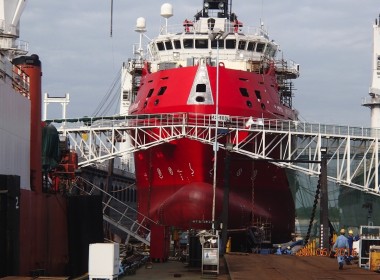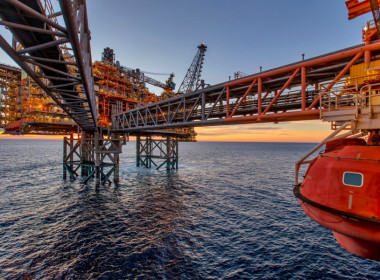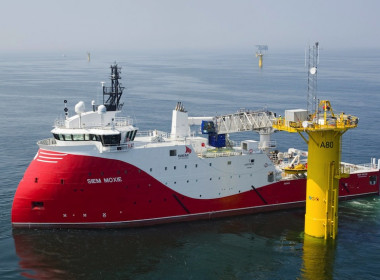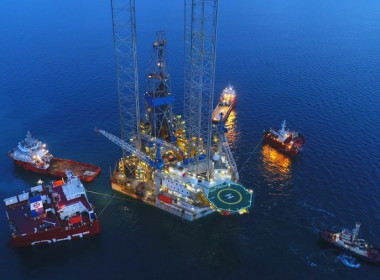COLUMN | Step on the gas! Woodside, BHP, Santos, Scarborough, Browse, Bayu Undan and Barossa [Offshore Accounts]

The best cure for high prices is high prices, as the old adage goes. Unfortunately, this offers scant consolation to gas consumers in Europe facing higher heating and electricity bills this winter.
And it is not just in Europe where consumers are feeling the pain. In Asia, too, spot LNG prices hit a record US$56 per million British thermal units (mmBtu) last month.
As prices spike at the same time that the world heads to “decarbonise,” there is a race to bring new LNG projects to production, both to take advantage of strong prices and rising demand, and in case the gas field operators cannot find funding ten or twenty years from now due to future restrictions on fossil fuel investments.
Gas demand set to surge
Reuters reported last month (here) that analysts from Morgan Stanley Research predict that demand for LNG is “expected to rise by 25 to 50 per cent by 2030, making it the fastest growing hydrocarbon over the next decade.”
At the same time, Morgan Stanley increased its long-term LNG price outlook to US$10 per mmBtu. The investment bank now expects LNG spot prices will, on average, be 40 per cent higher over the next decade, compared to the 2016 to 2020 period.
Higher prices will stimulate higher production to meet the rising demand. The Morgan Stanley researchers predicted that at least 73 million tonnes per annum (mtpa) of new LNG projects are needed to satisfy LNG demand by 2030.
High gas prices are great news for the offshore sector. It was only three years ago that Go Marine, one of Australia’s largest domestic offshore support vessel (OSV) operators, went spectacularly bankrupt, owing the Australian tax office AU$86 million (US$61 million) of which less than US$2 million was ever recovered, before the company was sold to a mysterious Hong Kong buyer (here).
Now Australia is once again at the forefront of an LNG renaissance, and Go Marine stands a chance to contribute to the Australian exchequer, as offshore activities there rise once again.
Woodside’s Scarborough receives green light
Woodside has stepped up to the plate with a new LNG project – the US$12 billion Scarborough project in Western Australia. This will be the largest oil and gas investment in Australia since the rush of gas developments that kicked off a decade ago, and culminated in the horribly overbudget Crux and Gorgon LNG projects.
Last week, Woodside announced (here) that the final investment decision had finally been taken and that the Scarborough project was proceeding, with first LNG exports projected in 2026.
Woodside CEO Meg O’Neill made the point that the economics for Scarborough were compelling, with a forecast payback period of just six years and an estimated internal rate of return (IRR) above 13.5 per cent. Compare this to the 3.6 per cent IRR that Norwegian researchers calculated Equinor would receive from its largest wind farm investment, as reported by Upstream (here). Ouch!
Ms O’Neill estimated the all-in cost of supply for Scarborough LNG delivered to north Asian customers would be roughly US$5.8 per mmBtu – just over 10 per cent of October’s spot price. Win-win!
BHP exits oil and gas
In August, we highlighted here that the only way Woodside was going to demonstrate any growth in the coming decade would be to succeed with its proposed merger with BHP Billiton’s petroleum division, which would also allow Ms O’Neill to give the green light to the Scarborough gas project.
On November 22, Woodside finally announced (here) that it had signed a binding share sale agreement for its merger of BHP’s oil and gas portfolio with Woodside. Woodside will acquire the entire share capital of BHP Petroleum International in exchange for new Woodside shares.
Woodside also announced that it had found a 49 per cent co-investor for the second LNG train at Pluto to process the Scarborough gas. The purchasing entity is Sharon Acquirer Trust, an investment entity owned by funds managed or advised by Global Infrastructure Partners. Global Infrastructure Partners’ funds are also the owners of Gatwick and Edinburgh airports in the UK, part of Adnoc’s pipeline businesses in the UAE, and several wind farms in Europe (here).
So, everything is lined up.
The Scarborough plan
Woodside’s project plan for Scarborough is to initially develop the estimated 11.1 trillion cubic feet (314.3 billion cubic metres) of dry gas with eight subsea wells, and an additional thirteen wells drilled over the life of the field. All the wells will be tied back to a semi-submersible floating production unit (FPU) moored in 950 metres of water close to the Scarborough field.
Approximately five million tonnes per annum (Mtpa) of Scarborough gas will be piped through a 430-kilometre-long trunkline to be processed at the Pluto Train Two LNG plant, with up to an additional three Mtpa processed through the existing Pluto Train One near Karratha.
Woodside says it expects the first drilling to commence towards the end of 2022 (here).
The winning contractors?
Woodside announced that the key contractors are McDermott for the FPU; the Subsea Integration Alliance (a joint venture of Subsea 7 and Schlumberger) for the subsea hardware, risers and flowlines; Valaris for the drilling; Europipe for the trunkline pipe; and Saipem for the trunkline installation. This reinvigorates a rather moribund Australian offshore sector and should provide several years of OSV charters to support the activity.
Green ire directed at Woodside
What was good news for MMA Offshore and Go Marine was less well-received elsewhere. The decision to proceed with Scarborough prompted environmentalists to protest outside Woodside’s offices in Perth.
Meanwhile, ABC reported (here) that three activists “locked themselves to concrete barrels, and used a car and caravan to block access” to Woodside’s gas production hub on the Burrup Peninsula, near Karratha in Western Australia, last Wednesday. They have now been charged with public order offences, after the ABC described that “specialist police” had to be flown in from Perth (two hours’ flying time away) to help remove them – which must have increased the carbon footprint of the protest significantly. The police claimed the demonstration “drained their resources and endangered the public.”
If a car and a caravan and three people chained to a concrete barrel can disrupt access to one of Australia’s largest energy facilities for twelve hours, one wonders how Western Australia might deal with a more serious blockade by environmentalists, let alone a terrorist attack on an LNG plant. We digress.
Gas versus coal is a no-brainer (in theory)
Campaigner Mark Ogge, who advises The Australia Institute, said the Scarborough project was “outrageously irresponsible”. He told the ABC that “there’s this hackneyed old talking point by the oil and gas industry that gas is a transition fuel — it’s complete nonsense. It’s arguing gas has lower emissions than coal and will displace coal, with overall lower emissions, but the reality is it’s largely displacing renewable energy, which is zero emissions.”
We disagree with Mr Ogge on this point, as we have argued here. The evidence from Europe and North Asia strongly shows that increases in renewable power need to be backed by increases in gas generation to provide baseline generating capacity, instead of using coal. European nations are not closing down wind farms to accommodate new gas-fired power stations. Instead, they are closing down coal-fired power stations and replacing them with a mix of gas and renewables, especially solar and offshore wind.
Every month we run a new story highlighting the inexorable growth of offshore wind (most recently here) and we don’t see this as being waylaid by a parallel growth in LNG consumption in the next decade at least.
Besides, Woodside claims that Scarborough will provide the lowest emissions intensity LNG exported from any project in Australia, with the reservoir containing only roughly 0.1 per cent CO2.
Advance Australia fair?
Shockingly to foreigners, Australia still relies on coal power for 54 per cent of its electricity generation (here) – around the same percentage as China, which was widely pilloried as the world’s largest polluter at the recent Glasgow climate change conference. China burns around four billion tons of coal a year (see here). But in terms of pollution per head, Australia beats China hands down, and even Saudi Arabia (here).
The ecological rationale for choosing gas over coal is obvious. For every therm of energy generated from burning coal, twice as much CO2 is generated compared to burning LNG, along with all the nasty particulates, heavy metals, and other pollutants that coal power generation creates.
Earlier this month, Delhi was blanketed in toxic smog, again, and Bloomberg was reporting that the Indian authorities were shutting down several coal-fired power stations in a desperate effort to reduce suffocating pollution levels (here).
Surely replacing coal with a mix of LNG and renewables is good for everyone?
Emission in the production process is LNG’s dirty little secret
But the Karratha protesters do have a point – the process of cooling methane to a liquid at minus 160 degrees Celsius is energy intensive, and often CO2 is also found in the same gas reservoirs and is vented into the atmosphere during the LNG production process.
The five-train North West Shelf LNG plant on the Burrup Peninsula emits about seven million tonnes of greenhouse gases a year, whilst the current first train of the Pluto LNG plant, which is 90 per cent owned by Woodside, emits the equivalent of two million tonnes of carbon dioxide a year (here). To put that in context, the North West Shelf LNG plant generates more CO2 than the entire African nation of Namibia, with its population of 2.5 million (here).
And that is before the Australian LNG is burnt by its end users.
Browse Basin LNG is high carbon
The future of Woodside’s Browse project, which has been earmarked to provide future feedstock for the North West Shelf LNG plant, is in jeopardy simply because that reservoir contains so much more CO2 compared to Scarborough.
Peter Milne has written (here) that gas from the Browse reservoirs contains between eight per cent and 12 per cent CO2, that Woodside plans to vent to the atmosphere at the LNG plant if the project proceeds.
Yes, you read that correctly. Meg O’Neill, so keen to tout her environmental credentials on Scarborough, has proposed that for Browse, the CO2 is simply released into the atmosphere. Milne found that “Browse will emit more CO2 to produce a tonne of LNG than any current Australian LNG project.”
Why would Woodside do this? To save money, obviously!
Carbon capture and storage is back…
Successful carbon capture and storage (CCS) would mitigate these emissions from the Australian LNG plants – but successful CCS has so far been very limited, despite the efforts of the oil and gas industry’s public relations machine.
Injecting CO2 underground in a nearby reservoir has been proposed as the solution to Browse’s CO2 problems. If carbon storage could be achieved in the existing depleted North West Shelf fields, the emissions from the NWS LNG plant could be dramatically reduced when it received Browse gas.
This would involve the Browse reservoir CO2 being piped 900 kilometres in the raw gas to the NWS LNG plant, then separated from the gas and piped back offshore 135 kilometres to (probably) the North Rankin and Perseus fields for sequestration and storage. Rankin and Perseus provide the existing feedstock for the plant, but both are depleting now.
That’s a lot of pipeline, and a lot of extra capital expenditure, which Ms. O’Neill would rather keep for herself and her shareholders, even if it involves millions of tons of unnecessary CO2 emissions from the LNG plant.
Time to go long on pipelay companies like Saipem and Allseas? Maybe, if CCS works.
But so far, it hasn’t.
Chevron admits failure on Gorgon CCS
Earlier this month, Chevron and its partners in the Gorgon LNG project in Western Australia agreed to buy carbon credits, likely to cost more than US$180 million, as a penalty for failing to meet a five-year target for CCS at the plant on Barrow Island (here). In the context of a project as flawed and badly executed as Gorgon, which cost over US$55 billion to bring to production, this penalty is barely material – and, as Bloomberg compellingly demonstrated here, carbon credits are a complete scam anyway.
Harbour has its hand out
That said, the oil and gas industry is under incredible pressure to reduce its emissions, and higher LNG prices justify further investment in CCS by the industry – indeed, countries like Australia, Norway and the UK desperately need CCS to work if they are to meet their commitments for carbon emissions reduction.
In the UK, we have seen Harbour Energy put its hand out for taxpayer subsidies for its CCS scheme (here), even though Harbour itself has so many tax credits that it will pay no tax in the UK until 2025. You won’t be surprised that Shell, BP, ENI and TotalEnergies also have CCS ambitions in the North Sea, and ambitions to receive UK taxpayer funds to help (here).
Barossa and Darwin LNG have big CO2 problem
Another Australian project with a major CO2 emission problem is Santos’ Barossa project, as Reuters describes here. This US$3.6 billion project (see here) sees gas piped from the Barossa field to the Darwin LNG plant from an FPSO. The gas export pipeline will be tied into the existing Bayu Undan to Darwin LNG pipeline. First gas production is targeted for the first half of 2025.
Now Santos has proposed using the empty reservoir of the nearby offshore Bayu Undan gas field off Timor-Leste as a CCS site. Bayu Undan is expected to stop producing in 2023. After providing the government of Timor-Leste with more than US$23 billion in revenue over the life of the field, it may yet provide further revenue as a carbon storage site for Barossa.
“We are yet to discuss the commercial model for the CCS project,” Reuters quoted Florentino Soares Ferreira, the president of East Timor’s National Petroleum and Minerals Authority as saying. “But the government of Timor-Leste sees this as a great opportunity not to be missed.”
Koreans drive change
Santos and the East Timorese believe that the Bayu Undan reservoir could eventually be able to store 10 million tonnes of CO2 per year. The initial plan for Barossa required the CO2 is stripped out and vented in Darwin, but now South Korean lenders and partners are threatening to withdraw funding for the project unless its emissions footprint can be reduced. Santos and its partners have all committed to net zero emissions at their operations before 2050, which would be impossible if millions of tons of carbon were being released into the atmosphere.
So, Santos’ new plan involves stripping CO2 from Barossa gas at the Darwin LNG plant, then transporting the CO2 by a new, roughly 120-kilometre-long pipeline, which would then hook up to the existing Bayu Undan pipeline and send the CO2 back for injection in the Bayu Undan reservoir, 380 kilometres further away.
Again, great news for pipelay players.
Pedal to the metal for LNG
The decision to proceed with Scarborough as gas prices surge in Asia can provide hope to two of the region’s other long-stalled other gas projects. In Indonesia, the massive but very remote Abadi gas field in the Arafura Sea has been stalled by operator Inpex, after years of arguments with the Indonesian government over how the field should be developed.
The delays with Abadi are absurd and environmentally unconscionable at a time when Indonesia still plans to build over one hundred new coal-fired power stations with a total capacity of over 21 GW (here). The economics of Abadi should be improving, as gas prices and gas demand remain high. Everyone recognises that building one hundred new coal-fired power stations is ecological idiocy, but Indonesia is a country that continues to fell primary rainforest and burn peatlands without any shame.
East Timor’s Sunrise offshore gas field also stalled after two decades of wrangling between lenders, a cash-strapped government in Dili, and various other stakeholders.
Both these projects would benefit from fast-track production by Floating LNG. Already Malaysia’s state-owned energy company Petronas is reported to be about to approve final investment on its third Floating LNG vessel. Energy Voice reported (here) that Petronas has now awarded front-end engineering and design (FEED) contracts for the unit, just after it celebrated a landmark fiftieth LNG export cargo from its first FLNG Satu unit in October (here).
At the same time, ENI announced that its massive FLNG unit for the deepwater Coral Sul gas field off Mozambique was ready for sailaway from Korea (here). Coral Sul should be producing in mid-2022. Gas is going strong.
But without credible CCS to reduce emissions and make possible blue hydrogen and ammonia schemes for emission-free fuel, the next LNG boom of the 2020s may be the last.
Coal is bad and will be phased out. Then gas will be next.
Background Reading
Woodside’s presentation on the Scarborough project is here.
Our coverage of supposedly carbon neutral LNG is here.
We covered Shell’s massive Prelude Floating LNG project here.
Not withstanding the abject failure of carbon offsets, many companies seem drawn to their purported benefits – for example, see this social media post from survey company Ocean Infinity here.
We once again refer you to The Juice Media’s cruel, expletive-ridden take down of CCS here and on Net Zero by 2050 pledges here.
See this recent editorial in The Jakarta Post to understand Indonesia’s lax environmental protection.








